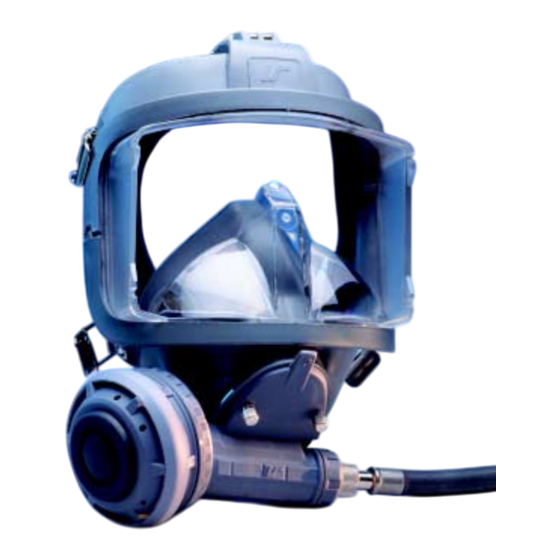Summary of Contents for INTERSPIRO Divator MKII
- Page 1 Instruction manual Divator MKII Face mask...
-
Page 2: Table Of Contents
Contents Special points Technical description Face mask Low volume diving visor Breathing valve Breathing valve with positive pressure Usage Preparation Donning Removing the mask Cleaning Daily care: Assembly after cleaning Function test after cleaning Inspection Diving in low water and/or air temperatures 1. -
Page 4: Special Points
INTERSPIRO is not responsible for maintenance and repairs car- ried out by third parties. Nor is it responsible for improper handling or use. The guarantees and warranties by INTERSPIRO specified in the conditions of sale are not extended by these “special points”. -
Page 5: Technical Description
Technical description FACE MASK The DIVATOR MKII face mask has been tested in accordance with EN 250.EC Type-examination (Directive 93/68/EEC) by SGS Yarsley ICS Ltd, East Grinstead, West Sussex, RH19 1 ET, UK (Notified body No 0120). The mask with inner mask is made of rubber and provided with a flat visor. The mask has holed studs for fitting spectacles. -
Page 6: Breathing Valve
BREATHING VALVE The breathing valve is of the demand type i.e. air is only supplied during inhala- tion. Owing to the balanced valve function the breathing resistance can be kept ex- tremely low, in spite of variations in the secondary pressure which may occur e.g. -
Page 7: Usage
Usage PREPARATION 1. Connect the breathing valve to the mask by pushing the valve into the connection piece and by turning it anti clock-wise so that it grips in the bayonet coupling. 2. Lock the breathing valve in posi- tion with the cover which should be pressed on and the screws tight- ened by hand. -
Page 8: Donning
DONNING 1. Adjust the pressure equalizer pad to a position which permits easy breathing through the nose. 2. Pull out the head harness straps as far as possible and put on the face mask 3. Tighten the head harness straps moderately. - Page 9 4. If necessary, pressure equalize by pressing the breathing valve up- wards. 4. Inhale deeply to turn on the posi- tive pressure automatically (alter- natively press lightly on the purge button, see figure). Stop breathing and listen for any leakage. If there is a fitting leakage check that hair has not come between the mask and the face and adjust if necessary the...
-
Page 10: Removing The Mask
REMOVING THE MASK 1. Unlock the buckles and loosen the head harness. 2. Turn off the positive pressure by pressing the black lever on the breathing valve towards the valve housing. See figure. 3. Remove the mask. -
Page 11: Cleaning
After prolonged use or when the apparatus is very dirty the following procedure should be carried out by a person authorized by INTERSPIRO: 1. Close the cylinder valve and switch on the positive pressure. - Page 12 5. Dismantle the breathing valve in the following way: a) Unscrew the locking ring and re- move the positive pressure unit from the valve housing. b) Seal off the connection nipple and the inlet channel with rubber plugs. c) Hold the positive pressure unit and loosen the diaphragm assembly by squeezing the thread of the cover.
- Page 13 e) Remove the positive pressure spring and the guide disc from the positive pressure unit cover. d) Remove the sealing disc and the exhalation diaphragm from the dia- phragm assembly. Do not disman- tle the diaphragm assembly any further. e) Remove the protective ring from cover if necessary. Further dismantling of the breathing valve should only be carried out by an authorized service man.
- Page 14 6. Wash the face mask and the breathing valve dismantled as described above. Use soap and warm water (maximum 40 °C). Scrub with a brush if necessary. Instead of soap a detergent can be used. Note! Strong detergents should be avoided as these may damage rub- ber and plastic materials.
-
Page 15: Assembly After Cleaning
ASSEMBLY AFTER CLEANING 1. Check that the rubber parts are supple and without cracks or other defects. Damaged parts should immediately be replaced. Any repairs to the breathing valve should always be followed by a function test on the test equipment. 2. -
Page 16: Function Test After Cleaning
FUNCTION TEST AFTER CLEANING 1. Connect the breathing hose to the breathing valve and push the lever to the off position (i.e. against the valvehousing). Open the cylinder valve. No flow of air should be heard. A flow indicates a leakage. 2. -
Page 17: Diving In Low Water And/Or Air Temperatures
Diving in low water and/or air temperatures Colder environments always involve greater risk of freezing in a breathing ap- paratus. We recommend the use of the full-face mask at low temperatures be- cause it provides better protection for face against cold. It is also physiologically correct because the inhalation air is warmed and moistened in the nose. -
Page 18: Face Mask
2. Face mask The face mask has been developed in order to protect the diver's face against cold and to make it possible to warm and moisten the breathing air on its way through the nose before it reaches the lungs. The DIVATOR MK II full-face mask has completely separated inhalation and exhalation channels. - Page 21 SWITZERLAND: Interspiro AG, Güterstrasse 47, CH-4133 PRATTELN. Phone +41 61 821 82 82, Telefax +41 61 821 17 86 UNITED KINGDOM: Interspiro Ltd. 7 Hawksworth Road, Central Park, Telford, Shropshire TF29TU, Phone +44 1952-200190 Fax:+44 1952 299805 INTERNATIONAL: Interspiro Europe AB, Box 10060, S-181 10 LIDINGÖ, Sweden.




Need help?
Do you have a question about the Divator MKII and is the answer not in the manual?
Questions and answers